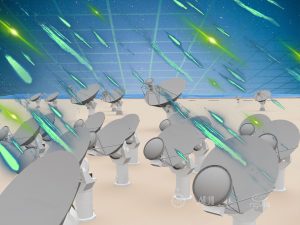
An artist’s impression of the Next Generation Very Large Array (ngVLA) detecting radio signals from extraterrestrial intelligence. Image credit: NRAO/AUI, with additions by Luka Vlajić, who was inspired by a similar artwork produced by Danielle Futselaar and Breakthrough Listen.
A new telescope strategy may bring astronomers closer to figuring out whether we’re alone in the universe.
Along with her team, Dr. Cherry Ng of the Dunlap Institute for Astronomy and Astrophysics at the University of Toronto has published a detailed plan on how to use a promising new telescope to its maximum capacity, in order to figure out whether extraterrestial life exists on other stars or planets.
Ng says that up to this point, astronomers have only searched a relatively small amount of the sky for intelligent signals from extraterrestrials.
“To date, only a few thousand stars have been sensitively searched for artificial signals,” explains Ng. “That’s a tiny fraction of the total number of stars in the Milky Way.”
Her plan to address this shortcoming centres on the Next Generation Very Large Array (ngVLA), a vast network of dishes currently in a design phase. When complete, the ngVLA will be the one of the most sensitive radio telescopes ever built. The ngVLA will be capable of covering a larger area of the sky, collecting data from more stars and exoplanets, and locating signals at farther distances than has been previously possible with current telescopes. This is due to its large number of dishes, and the very wide range of frequencies it can analyze.
In results reported today in The Astronomical Journal, Ng and her team explain how a technique that they refer to as “ethernet-based commensal observing” can be used on the ngVLA to accelerate the search for other civilizations. This approach would allow multiple users to subscribe to the data stream, and would effectively provide multiple telescopes in parallel. “Traditionally on a telescope there is only one data stream, so only one group of astronomers can use the data,” Ng says. But using her approach, the science output can be massively multiplied.
Ng’s team also proposes to use only the core antennas – the part of the telescope where the radio dishes are packed together closely, to be able to view more of the sky at any given time.
Ng explains that the search for extraterrestrial intelligence is really a search for technology. “Current efforts are focused on the detection of what we call ‘technosignatures’ – technical indicators such as an artificial radio signal that, whether intentionally or unintentionally, are transmitted by some intelligent form of life out there.”
Leo Rizk is a fourth-year undergraduate student in the David A. Dunlap Department of Astronomy and Astrophysics at the University of Toronto, and a key author on the paper. He is excited by what the team’s new strategy can contribute. “Past searches for technosignatures have been surprisingly modest in scope,” he says. “A lot of frequency ranges and sky area are still yet to be searched. And that’s something the ngVLA can address.”
“We are excited by the promise of ngVLA to carry out leading-edge technosignature searches, and appreciate the strong community help in designing the instrument to support this important science” said Director of the U.S. National Radio Astronomy Observatory and ngVLA Project Director Dr. Tony Beasley.
Ng says that the ngVLA offers great potential to achieve the technological capabilities needed for detection of an extraterrestrial signal.
“This is an exciting and significant step toward answering one of the biggest questions we can ask: are we alone?”
_____________________________________________________________________________________
This work was funded by the ngVLA community study program and conducted in partnership with the SETI institute in the US, as well as the University of Galway in Ireland.
Associated Publication Information:
FOR IMMEDIATE RELEASE
For more information, please contact:
Meaghan MacSween
Communications and Multimedia Officer
Dunlap Institute for Astronomy & Astrophysics,
University of Toronto
meaghan.macsween@utoronto.ca
